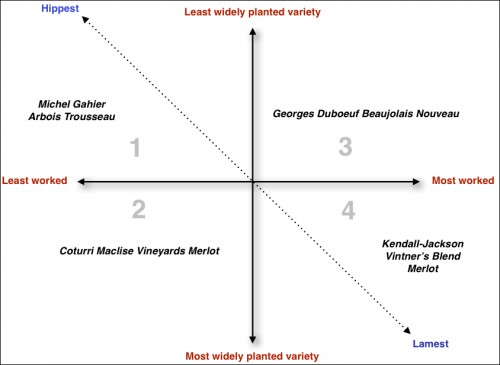I’ll admit to being a little in love with the analytic tool known as the semantic square (aka Boston box). There’s seduction in the way it gives clarity to certain kinds of ideas one struggles to achieve by other means. A skillfully designed square is particularly good at illuminating how perceptions shift as you move from one position to another along notional axes.
The one below is a result of my interest in a phenomenon we’ve been watching for several years now: the fashion among younger wine enthusiasts and the retail shops and sommeliers who cater to them away from well-known wine producing regions and international varietals toward lesser known regions, hyper-local cultivars, and naturalist approaches to winemaking.
It’s been clear for some time that what once was a modest outpost of wine counter-culture has migrated toward the normative — not at your local Capital Grille (or is that Capitalist Grille? I forget.) maybe, but in smaller, independent, mostly urban restos/wine bars with a claim to have their fingers on the pulse. Today the epitome of cool is the wine bar where you don’t recognize a thing on the list and everything came into being with as little winemaker intervention as possible.
As in all fashion systems, the goal seems to be for insiders to distinguish themselves sharply from outsiders by creating barriers to comprehension. In other words, you can’t join the club without understanding the code. What follows attempts to show how the code operates in this particular instance. It also suggests how reflecting on the means we use to conceptualize wine can offer insights into what we choose to drink and why.
In the chart, the y (vertical) axis represents the degree to which the grape variety used to make a wine is (geographically) either widely or narrowly planted. The X axis tracks the degree of technical intervention in the vineyard and cellar applied to producing the wine. The assumption is that the hierarchy of hipness is determined by where on the square the wine is located based on its X and Y co-ordinates.
High prestige wines derive from the most localized grape varieties treated to the least manipulation in the vineyard and cellar, while low prestige wines have exactly the opposite profile.

Hurrah for Michel Gahier, then, whose wine is made from a grape (Trousseau) found almost exclusively in the Jura, the region in eastern France where Arbois (a rather obscure AOC in its own right) is located. One could argue about just how far out on the X and Y axes Gahier’s wine deserves to be (he’s a noted advocate of the naturalist approach). But let’s not quibble, the pairing of a hyper-local varietal with a minimum of technical intervention constitutes a twin killing, placing him in the elite quadrant 1. Score it Exceedingly Hip, at the very least.
But boo, hiss for Kendall-Jackson Vinter’s Blend Merlot, relegated to quadrant 4 for combining one of the world’s most ho-hum grape varieties (Merlot) with relentlessly technical winemaking . Your 25 year-old sommelier with the skinny jeans and the narrow-brimmed fedora wouldn’t give it so much as a sniff — not even for purposes of appearing ironic. On the plus side, your mother might like it.
Pairing a hyper-local varietal with a minimum of technical intervention constitutes a twin killing. Score it Exceedingly Hip, at the very least.
We relegate Georges Duboeuf’s Beaujolais Nouveau to quadrant 3 because although its constituent grape, the Gamay Noir, isn’t an everyday varietal, it’s far from what would qualify as exotic and so doesn’t get us too far on that account. On top of that, Duboeuf’s ocean of Nouveau is first sourced from hundreds of mediocre or worse vineyards, then beaten into humdrum consistency via a punishing level of technical manipulation, pushing its x coordinate deep into the ‘most worked’ red zone. Can’t do better than quadrant 3, I’m afraid, Georges. Come back when fashions change … for the worse.
Coturri’s Maclise Vineyards Merlot presents something of a dilemma, too, but shifted to a different axis. The Coturri brothers are celebrated as uncompromising practitioners of naked-as-a-jaybird winemaking in California — a stature that assures them a gratifyingly remote position far out at the ‘least worked’ end of our X axis.
True, they cede some cred for working with the frightfully square Merlot, but my guess is that in terms of grading the cool, a naturalist approach trumps a trite varietal every time. There would be extra points if Tony Coturri cut his flowing beard down to a soul patch and replaced his overalls with jeggings, but we put them firmly in quadrant 2.
Exactly why we privilege one kind of wine over another at a given point in time isn’t entirely clear, but as with most things, there are rules at work and a semantic square is often a good way of sussing it out. Feel free to use it in your next visit to one of those puzzlingly ironic wine bars.
But if you get arrested for impersonating a hipster, you’re on your own.
This post was originally published on May 15, 2012. Reach me at stephenmeuse@icloud.com